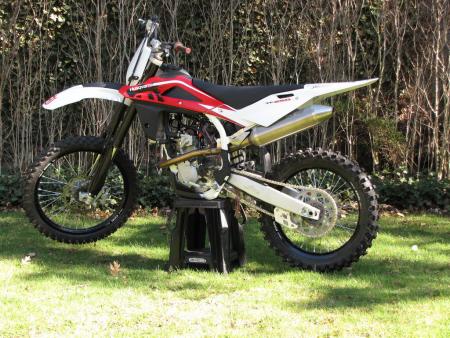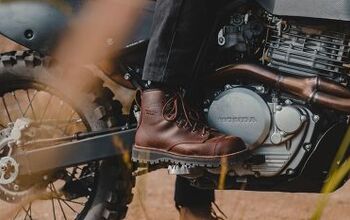2010 Husqvarna TC 250 Review - Motorcycle.com
Husqvarna has been making motorcycles since 1903, winning championships in just about every discipline of racing since day one. It practically introduced motocross to North America in the 1960s and dominated all forms of dirt racing in the early to mid ‘70s before gradually fading.
Company ownership changed hands, the dealer network faltered and manufacturing moved from Sweden to Italy. Things improved under the Italians, and success began to creep back on the track, if not in sales. Recently BMW bought Husqvarna, injecting cash and new life into the brand. These efforts are showcased across the entire Husqvarna product line but shine most brightly in the new TC 250.
The TC 250 has the lightest weight of any bike in the 250cc thumper class. It’s enough of a difference that you can feel it the second you lift the Husky off a bike stand. Husky says it weighs a mere 209.4 pounds dry, and while that may be optimistic it is probably fairly close to reality. It is definitely lighter than the other 250 strokers on the track, and by a sizable margin.
The all-new engine is a welcome departure from older versions, which were essentially sleeved down versions of the company’s mid-sized four-strokes. External dimensions on the titanium-valved engine are 13% smaller than before and weight was cut to a mere 48 pounds. With the engine in the frame and without removing the fuel tank you can easily access the spark plug, cylinder head and 39mm Kehin carburetor…in fact everything about the new Husky is incredibly easy to service. Paired with new, minimalist bodywork, the bike is mechanically stunning in its simplicity.
The fork on the Husky, previously sourced from Marzocchi, is now made by Kayaba. Out back you’ll find a Sachs shock, featuring all the usual adjustments and suspension linkage. The brakes, by Brembo, are exceptionally smooth and powerful. The entire package is wrapped in a Cro-Mo frame with beautiful welds.
Let’s get to the good stuff. What’s this bike like to ride and more importantly, is it competitive?
Every single one of the eight riders of various sizes and abilities we selected used the word ‘friendly’ to describe the Husky at some point in their test sheets. Unfortunately, friendly doesn’t mean fast. The engine produces good low-end torque before oozing into to a very smooth and linear powerband right up to the rev limiter. We compare it most directly to the 2010 Honda CRF250R we tested last fall, but add that the Honda is slightly more powerful overall and the Husky makes better low-end torque.
Our three Pros were all disappointed at the raw power of the Husky, making comments like, “This motor is slow compared to the other 250F’s, but at least it has very broad, linear power.” Here’s another Pro comment; “Too smooth for a 250F. It would be good on slippery surfaces but lacks ‘hit’.” For the rest of us the engine was fantastic. It shifted great, the hydraulic clutch was light and easy to modulate and the raw power was more than adequate. “It’s fast enough,” said our Vet rider. Our intermediates craved the usability of the wide powerband.
Carburetion on our test bike was spot on, after some dealer-installed jetting revisions to help improve starting. Cold starts are a breeze but hot starting was still a hit or miss affair, even after the jetting update. A big part of this is the hot start button, which is still mounted on the carburetor instead of the handlebars like most Japanese bikes. In the heat of battle this is a big deal! Husky has a remote hot start kit in their parts catalog. Buy one. Also remember, this is a new engine. It may have been proven in international competition over several years but it’s still new to us, so long-term reliability is a question mark.
Suspension was another mixed bag. The rear suspension, even with its unusual Sachs shock, drew few complaints. No tester, from novice to fat old guy rated it below 8 out of 10. One of the intermediates said, “The back end absorbed bumps like a dream. I wouldn’t touch a thing.” On the other hand the pros all complained it was too soft but noted that the bike tracked well and didn’t bottom harshly. The fork, on the other hand, was regarded by every single tester as being too soft and blowing through their travel too quickly. We tried different compression settings which helped a little, but from the Pro rider notes the answer was clear; “…desperately needs stiffer springs and heavier valving for motocross, even for a lighter rider.” From our novice tester, “Plush. Maybe even too plush…even for me.”
Light, smooth and soft do have their advantages – namely turning. This little Husky is on rails. It carves, drifts and hammers through turns with precision. Somehow, the bike remains stable at speed, even on a whooped out sand track. “Handling is the best thing about this bike!” raved one of our Pros. “Handled great,” and, “Loved the handling!” were intermediate comments. Unfortunately, in the Lites class, it takes more than great handling to win races. Or does it?
ZipTY Racing/Husqvarna’s Cory Graffunder recently won the opening round of the Maxxis Endurocross series aboard a TC 250. He also happens to be a friend of mine. When I mentioned we had a TC lined up for a test he told me, “You’ll love it! Those things are awesome woods bikes!” You know what? He was absolutely right. The bike’s smooth power, light weight, awesome turning and soft suspension conspire to make this an absolute weapon for GNCC, Hare Scrambles or any other kind of racing where covering nasty terrain in a big hurry is required. The exhaust note is quiet and inoffensive and the bike even comes with a sturdy plastic skid plate!
As a true woods bike the Husky needs a bigger tank. Even for motocross the small capacity, just 1.9 gallons, is barely enough. The aftermarket can take care of that issue easily. Our riders thought the fork too soft for aggressive woods racing, though the shock was fine. The chain should be upgraded to a sealed unit. Add some bark busters and radiator guards and you have an epic small-bore woods weapon. The only other 250 that even comes close in that regard is the Honda CRF250R, though it isn’t as easy to maintain as the Husky.
So what do we have here? For Novice and Intermediate motocross racers the Husqvarna TC 250 is a viable weapon. Pros would need to spend money on engine performance and suspension upgrades. For off-road racing the Husky shines under any pilot. It handles so well it makes zeros into heroes.
The torquey engine, juice clutch and even the transmission and final drive gearing are well suited to life in the forest. You’ll still need to spend a few bucks, but no more than you would converting any other motocross bike for off-road racing. No matter who you are or where you’re racing the pipe burns your leg and the exposed oil line on the right side of the cylinder just begs to be snapped off by a footpeg or branch.
Bottom line? The Husky TC 250 is a good bike. But is it a great bike? Maybe, depending who you are and where you race it.
Related Reading
Husqvarna named VMD Marque of the Year
Husqvarna offers $11M contingency for 2010
Husqvarna announces 2010 US racing plans
2010 Honda CRF250R Review
More by Dan Paris

































Comments
Join the conversation